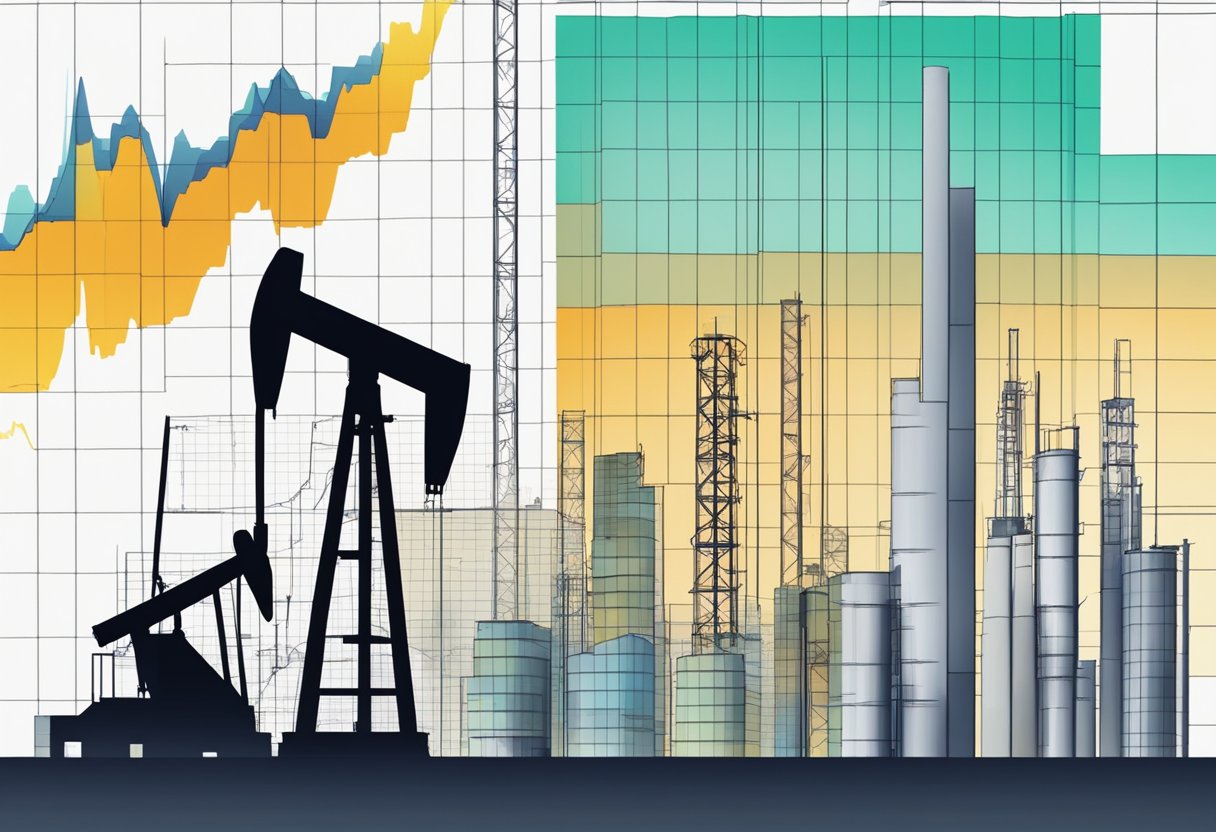Market volatility plays a critical role in the valuations of oil rigs, impacting the oil and gas industry profoundly. As an investor in the oil market or a stakeholder within the industry, you are likely aware that oil prices are susceptible to a range of market factors, including geopolitical tensions, supply and demand dynamics, and even climate change. This volatility can lead to significant uncertainty regarding the valuation of assets, particularly oil rigs, which are central to crude oil production. The connection between crude oil prices and oil rig valuations is complex, as these assets are a key investment in the exploration and production of oil and gas, especially in the context of the shale oil and gas boom.
Your understanding of oil rig valuations must also consider investor implications, as the oil futures market is closely watched for signs of shifts in sentiment towards commodity markets. Volatility in the price of oil can trigger sharp reactions from investors, influenced by factors such as environmental regulations, the broader U.S. economy, and even global initiatives to divest from fossil fuels in the face of climate risk. This magnifies the importance of a deep analysis of oil market volatility for making informed decisions in this sector.
The challenge you may face is twofold: gauging the current valuations of oil rigs amid fluctuating crude oil prices and anticipating future trends that may affect these valuations. As part of the oil & gas exploration & production sub-industry, you must navigate through this environment by comprehensively assessing market signals and volatility trends to mitigate risks and capitalize on opportunities. Bearing in mind the inherent uncertainties tied to fossil fuels, it becomes imperative to stay abreast of the latest developments and to factor in the long-term impact of market volatility on investment and the operational facets of oil production.
Oil Market Dynamics and Valuation Principles
When valuing oil rigs and assets within the oil and gas industry, understanding the underlying oil market dynamics is crucial. Your assessment should take into account several interactive factors, including oil prices, demand, and volatility.
Oil prices are influenced by a complex network of elements, where OPEC behavior, shale oil production, and economic growth of heavy players like China and the United States play significant roles. As you evaluate oil rigs, consider these market drivers and their potential impact on future commodity prices.
Volatility in the oil market often stems from both geopolitical and economic uncertainties. Oil price volatility can be seen as a double-edged sword for investments; while high prices can indicate a robust demand and incentivize exploration, severe price fluctuations may introduce risks that affect long-term asset valuation.
It’s also beneficial to factor in the size and production capacity of oil rigs. Larger operations in areas with considerable oil reserves may be valued higher due to their ability to capitalize on economies of scale and withstand market disruptions.
Keep in mind that U.S. refineries and exploration and production company sub-industries adapt differently to oil market volatility—an important consideration for potential returns on your investment. Moreover, the Canadian oil and gas industry presents unique opportunities and should align with global oil dynamics and commodity prices.
Looking at the broader picture, global uncertainty, including political stability of oil-producing countries, can cause oil price shocks, impacting the valuation of oil rigs. Investors need to assess how shifts in energy prices—encompassing not just oil but also natural gas—may influence the profitability of oil rig operations.
In summary, consider key factors that drive oil market dynamics—demand growth, supply changes, stability of crude oil market, and overarching oil production strategies. Your valuation must be a product of careful analysis of these aspects, ensuring your investment weathers oil market volatility.
Impact of Geopolitical and Economic Factors
Grappling with the complexities of oil rig valuations requires you to consider the intricate interplay between geopolitical and economic spheres. The valuation of oil rigs is deeply influenced by OPEC’s decisions, climate policies, and market responses to immediate crises—all of which can dramatically sway oil prices and market stability.
OPEC’s Influence on Oil Rig Valuations
The Organization of the Petroleum Exporting Countries (OPEC), led by key members like Saudi Arabia, plays a significant role in the oil industry. OPEC’s production targets can lead to shifts in the crude oil market, causing fluctuations in both oil supply and oil prices. When OPEC decides to cut production, oil prices are likely to increase, thereby raising the value of oil rigs. Conversely, increases in production can lead to a surplus, putting downward pressure on prices and rig valuations.
Climate Policies and the Future of Oil
The trajectory of the oil industry is being reshaped by climate change and the policies enacted in response to it. The Paris Climate Agreement and subsequent national regulations are accelerating the shift towards renewable energy. As more countries commit to reducing carbon emissions, the future demand for fossil fuels is uncertain. This uncertainty can discourage investment in new oil rigs, as the shift away from oil becomes more palpable, influencing long-term valuations.
Market Reactions to Shocks and Crises
Economic shocks and geopolitical crises can lead to immediate and pronounced impacts on oil prices and subsequently on oil rig valuations. For instance, conflicts in oil-rich regions can create supply constraints, propelling oil prices upward. Your portfolio might also witness volatility spillovers from the oil to the equity markets, making industries like the United States oil and gas industry vulnerable to global uncertainty. Furthermore, commodities like West Texas Intermediate are used as gauges of market sentiment during periods of financial crisis, often resulting in price volatility that can impact rig valuations.
Investment Strategies and Market Volatility
When considering investment strategies in the oil sector, understanding how market volatility affects equity values is crucial. Your approach to investment can either capitalize on short-term fluctuations or focus on long-term growth potential.
Volatility and Equity Values in the Oil Sector
Oil prices and equity markets have a complex relationship where the former significantly influences the latter, especially in sectors like oil and gas. Volatility in oil prices, often measured by indices such as OVX (the oil volatility index), directly impacts the equity values of companies within the oil & gas exploration & production sub-industry. Stochastic volatility models, like GARCH and VAR, are used to understand the conditional variance in oil market prices and their effect on individual oil and gas stocks. When oil price volatility is high, investors may witness a greater fluctuation in the equity values of these companies.
For instance, an increase in crude oil and natural gas prices can lead to a higher valuation of oil reserves, which in turn boosts the equity values of oil exploration and production companies. Conversely, a downturn in commodity prices can result in decreased equity valuations.
Long-Term Investment Vs. Speculation
The strategy you choose as an investor in the United States oil and gas industry can diverge into two paths: long-term investment or speculation. Long-term investment focuses on the growth potential and persistence of price returns driven by factors such as supply and demand, technological advancements in shale oil extraction, and forecasting improvements that enhance predictability. Commodity markets and global industry indices play a pivotal role in shaping the equity values in the long run.
Speculation, on the other hand, thrives on oil market volatility and aims to profit from short-term price movements. Strategic speculators closely monitor implied volatility measures like OVX and leverage volatility co-movements among S&P 500 constituents, including U.S. oil and gas shares, to make informed decisions. This approach requires a keen understanding of market factors and the volatility dynamics that govern oil and gas price fluctuations.
Your investment strategy in the volatile oil market should be informed by these insights, whether you’re looking to build a resilient portfolio or take advantage of the market’s cyclic nature.
Evaluating the Significance of Size and Technology in Valuations
When you consider oil rig valuations, understanding the interplay between size, technology, and the ever-evolving industry landscape is crucial for accurate assessments.
Shale Revolution Influence on Valuations
The Shale Revolution has redefined the economics of the oil and gas industry, particularly in the United States. This shift dramatically increased the oil supply, impacting the shale oil and natural gas sectors. Consequently, oil rigs capable of tapping into shale and other fossil fuel reserves are often valued more highly. The growth in fossil fuels production from shale resources contributes significantly to the U.S. economy. Oil rigs that can efficiently extract crude from these resources are crucial in a market where the crude oil price is subject to fluctuations.
Technological Advances and Cost Efficiency
Your evaluation of oil rig valuations should also consider the impact of technological advances on cost efficiency. Production technology such as hydraulic fracturing has been pivotal in modernizing the oil & gas exploration & production sub-industry. These technologies have not only increased the accessible fossil fuel reserves but also improved operational efficiency. A more technologically advanced oil rig might command a premium in valuations due to its potential for lower production costs and enhanced output capabilities. The use of models like the Heterogeneous Autoregressive (HAR) model can aid in anticipating future market behaviors, thus influencing rig valuations based on expected performances.
Your valuation should take into account the size of the rigs and their technological capability when considering the long-term sustainability and profitability in the volatile crude oil market.

